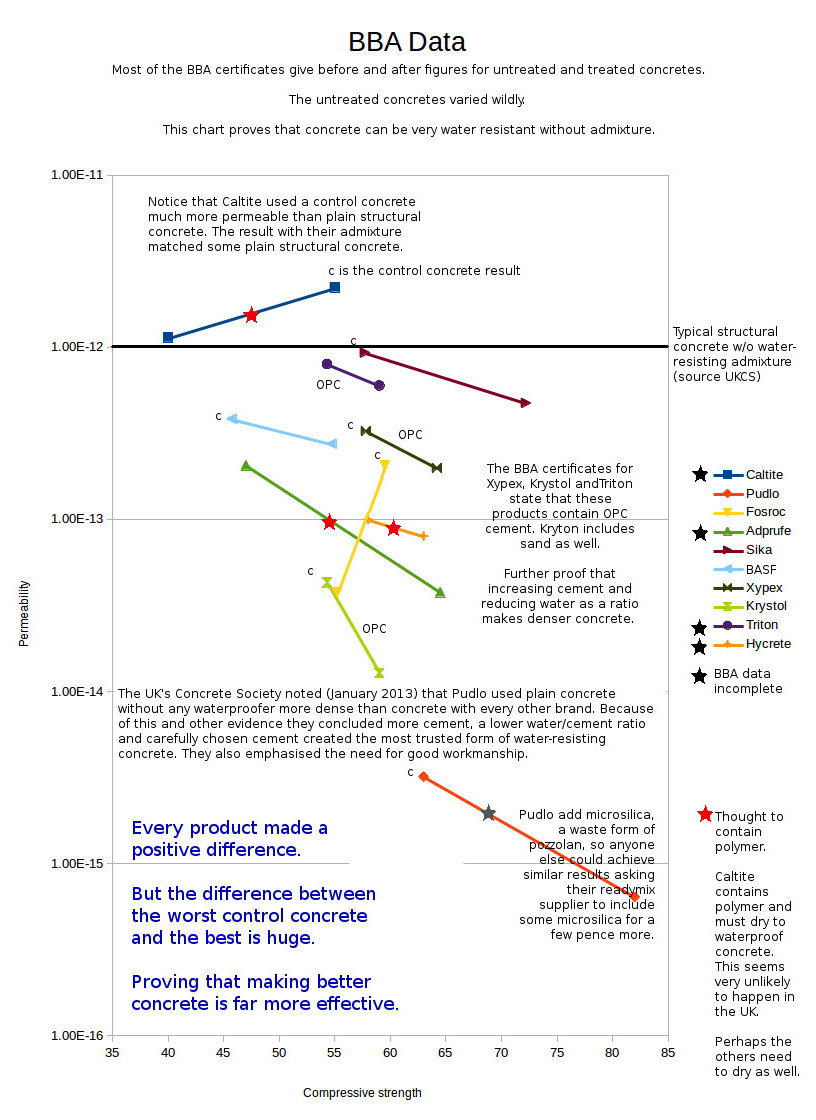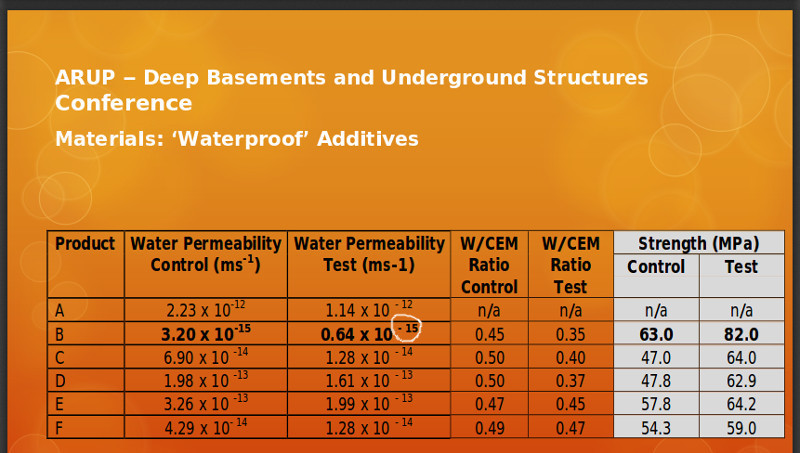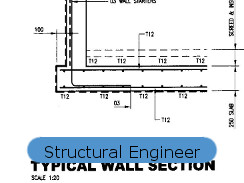|
|
Basement guarantees and insurance backed warranties.
I have been giving clients My Guarantee for many years. No one had a leak. No one claimed.
Some guarantees by others are explained further down this page after we present our own guarantee.
The final section debunks BBA certificates for water resisting admixtures.
The Basement Expert Guarantee.
Included after you bought all my relevant products and services.
My Guarantee is that there will be no visible ingress of water through the structure, whether through concrete or joints.
This means I am unique guaranteeing workmanship - mine and yours as well.
Subject to entirely reasonable terms and conditions.
|
|
|
I built domestic basements since 2005. Over that time I have developed methods that always work.
The only guarantee I give is in return for all my products and services appropriate to your job.
Legal bits:
-
I will have to approve your formwork including the height of each pour. I might want to be paid for an extra visit to do this.
-
You must use and pay for my powerful plasticiser, my supervision, poker hire, rods and nuts and anything else I tell you is necessary for success.
-
You, your design team and your workforce must have followed my direction and supervision throughout. This includes preparing joints and repairing any flaws I notice soon after formwork is removed. I must be invited to visit at the appropriate time.
-
You must buy and use the concrete mix I describe throughout all the work you want to be free of leaks. See the
buy waterproof concrete page for the mix design.
-
You must cure all waterproof concrete properly, that means slab surfaces prevented from drying out for 72 hours and wall formwork not loosened, which also means not removed, for 72 hours.
It is important to understand the timing of this guarantee.
A newly constructed basement should be inspected at the appropriate time to prove it is dry from the reinforced, waterproof concrete alone.
The appropriate time is after the new structure is weather-tight, which requires the roof to be on and the windows in and sealed against ingress of rain and other water.
The basement cleared and cleaned by the main contractor.
And after a period of heavy rain.
When the inspection is a success, my guarantee begins. Until then repairs should continue.
-
The guarantee is a personal guarantee only, by Phillip Sacre only,
- to stop any visible ingress of water through the concrete I treated with my powerful plasticiser
- to stop any visible ingress of water through joints between concrete elements treated with my powerful plasticiser
if you followed every condition published on this web site or linked to from this web site.
-
There must be no money outstanding. All invoices must be paid.
-
Note. If you claim you have a leak and Phillip Sacre visits site with repair tools and materials only to find that all you have is condensation, a charge of £400 plus travel will be invoiced and must be paid.
-
BS8102:2022 specifies that the basement structure should not have any part covered over inside until it is known not to leak, which would be the inspection above. The clause in our guarantee prior to that being the case still applies.
See 4.3.2 "the issue of repairability should be taken into account". You cannot repair, during the building phase, what was covered over before it was inspected.
The site of any water leak must be easily accessible, with working room and power available, be a safe area and not covered over (for instance by plasterboard or cables), have sufficient ventilation and it must be acceptable that we make a mess chiselling out hard concrete and mixing up repair compounds with water. The area we use for repairs will need a final clean by yourselves afterwards. The purpose of this clause is that no unfair advantage is made of this guarantee.
-
If you have any condition that hinders Phillip Sacre from carrying out repairs then the guarantee must be void.
-
Unlike Caltitie and Pudlo, and no doubt many others, the value of repairs is NOT limited to the value of materials purchased.
Phillip Sacre has been offering and honouring this same guarantee to his basement customers for years. No one claimed in relation to any concrete pour since 2013.
If you are told that you need an insurance backed guarantee, then please click on this link.
This link opens a page that tries to explain structural warranties simply.
Guarantees from others.
My comments on waterproof concrete guarantees.
After this text box, examples of BBA certificates that prove the product does not do what you presume it does.
First, my comments on waterproof concrete guarantees.
There are two examples of the Caltite guarantee on this web page. Where Caltite might have misled you is confusing the fact that Everdure Caltite, that contains a polymer, will waterproof non-waterproof concrete if the concrete is first kept moist inside and fully cured (which might take a month) then oven-baked long enough to dry the concrete and the polymer completely. They may have shown you an example where concrete above ground in Australia did exactly this. But beneath ground in Britain the polymer could not and will not work. Indeed, academic evidence is that if the polymer does not dry out it actually increases the transportation of water through concrete. The opposite effect.
You need to go to page 26 to find the exclusions in this Sika guarantee. Over the years I have had a few phone calls from people whose lives have been severely blighted by new basement construction suffering seemingly incurable waterproofing problems. All the worst sagas involved Sika. I was once called by someone calling himself a Sika sales manager who claimed this claim of mine was untrue. I was able to give him the phone number of one of these unhappy people. I didn't hear from him again.
If you go to the Kryton web site It all sounds very good until you realise that, like Sika, they are selling some extra cementitious powder and they promise only what extra cement will achieve. 0.25% extra cement does very little. But to say more water resistant, stronger, more durable would all be true even if only 0.25% true.
Pudlo and Xypex are selling extra cementitious powder as well. Let us not forget that the David Ball Group, that includes Pudlo, have a leak repair division as well.
If you think differently, then insist on a copy of the guarantee from whomever you prefer to specify.
You will find, I believe, that Caltite, Pudlo, Sika and so on will make all manner of excuses and not provide you with their actual wording.
I found some interesting comments on the Maclennan Waterproofing web site here.
This is truncated and I have edited bits together: "We work on 4–6 failed waterproof concrete basements a month where the additive companies have left the contractor and engineer with a water ingress problem to sort out. fail(ures) due to poor workmanship, cracks, honeycombing, and most commonly defective joints, hydrophilic strips and water bars".
I might add that all these brands have been fully aware of what I say about them for many years. I got phone calls of complaint from a couple of sales people but I have never had a written complaint from any of them. What I say is true and unchallengable.
The only proper way to determine whether concrete is waterproof is to take test cubes at site,
the same as the test cubes that are crushed to test compressive strength to BS EN 12390 part 3,
and have them tested at the lab to BS EN 12390 part 8. Penetration of water under pressure.
|
|
|
Why BBA certificates must no longer be taken at face value.
-
BS8102:2022 now makes it compulsory for specifiers to read and properly evaluate certificates.
-
At 4.3.2 "Materials should be used in accordance with the conditions and requirements set out in the relevant technical product information and in accordance with the manufacturer's recommendations by personnel trained in their use and application",
-
and again at 6.2.1."relevant manufacturers product information should be checked to confirm that the system selected is suitable for the structure for which it is to be applied"
-
In a court case brought against a building firm by a housing association following revelations at the Grenfell Tower inquiry, a judge determined that BBA certificates cannot be said to amount to a form of guarantee or a passport to compliance with Building Regulations.
And I have my own evidence showing, I believe, that waterproof concrete admixture suppliers cheated during BBA testing in much the same way it was reported the cladding and insulation suppliers to the Grenfell Tower had cheated.
None of the BBA certificates for 'so-called' concrete waterproofing additives prove the additive turns non-waterproof concrete into waterproof concrete, where used in a basement ground bearing slab or retaining wall.
The Grenfell Tower inquiry heard that the BBA was "hopelessly weak".
The Grenfell Tower inquiry told us that products are tested at BRE, who do the testing for BBA, and that the product suppliers themselves set up the tests and they were able to cheat the BRE inspectors.
I had a stout discussion with an architect after we both had new copies of BS8102:2022 who said that architects trust BBA certificates because they are certificates and evidence that a product works.
I explained that none of the BBA certificates for waterproof concrete provide any such evidence, and all but one were tested in concrete too stiff to be used on site. Most products were not tested in concrete any customer would buy. These tests were therefore invalid.
The only exception was BASF, but theirs was one of the worst performers.
He challenged me what certification do I have if I don't have BBA?
I explained that it seems only I took samples of waterproof concrete, delivered to site and used in my waterproof basement construction, and had them tested at a UKAS accredited laboratory to BS EN 12390 part 8 and every sample passed with flying colours.
Note. BS8102:2022 mentions BS EN 12390 part 8. It does not mention BBA anywhere.
It would appear that the committee writing the new BS8102 had some difficulty with BBA and waterproof concrete admixtures.
From BS8102:
"9.2.1.3 Concrete containing water resisting admixtures
COMMENTARY ON 9.2.1.3
There is a range of products, generally categorized as water resisting admixtures, which seek various ways to increase the inherent resistance of concrete to water and water vapour. As the mechanisms used each product to achieve these aims are quite diverse, it is not possible in this British Standard to give specific guidance on their use.
See Table 9 of BS EN 934‑2:2009+A1:2012 for guidance on requirements for water resisting admixtures.
"
I studied waterproofing concrete as best I could during 2012 and at the end I wrote to an academic with my findings. He wrote back to say that at about the same time a working group of 18 members of the Concrete Society had worked on a report "The influence of integral water-resisting admixtures on the durability of concrete" which, at that time, they had just published.
He said I had come to the same conclusion though they had done more work than I had. He thought I would find what they had to say about BBA particularly interesting.
The two quotations I would like to use from the report here are
-
"the working party was unable to obtain details of the constituents in most of the commercially available water-resisting admixtures."
-
"Lower permeability was associated in most cases with higher strength and it is not clear by how much of the improvement is simply due to a reduction in water/cement ratio.
"
My own conclusion was if the concrete mix was potentially very dense, which means extra sand, extra cement and a reduction in water/cement ratio, then if all the work associated with it was good then the concrete will be waterproof. A powerful plasticiser would be needed to enable the stiff mix to be placed and compacted.
Since 2013 I have been on the lookout for clues as to what else might be in these admixtures. Most of them contain very cheap extra cementitious powder for a lot of money. Some contain a liquid polymer that, if it were baked dry in full sun would dry and block pores.
The report says "water-resisting concrete should be able to resist water penetration under pressure as well as by capillary absorption." It suggests BBA certificates would be better and more useful with comparative testing of "depth of penetration of water under pressure to BS EN 12390-8".
I have tested my powerful plasticiser in concrete samples taken at site to BS EN 12390-8 many times. They all passed.
If all the brands were all tested they should pass as well - because they all instruct their users to buy the same mix of concrete and they all contain a plasticiser.
Testing every brand and my own powder would provide added proof that you don't need a brand.
|
|
Please note and understand. Any crystals or crystalline 'magic' are the crystals that result from water mixing with cement/cemetitious material. An admixture that grows crystals isn't magic. It has a cement in it.
This chart is from the report referenced above. It shows data from each product's BBA certificate.
It shows that Pudlo improved concrete already very, very good before they added their cementitious powder, which improved it only very slightly.
Others started off with good concrete. Also better than standard structural concrete. They also got a slight improvement with their admixture. But their concrete was still less water-resistant than the concrete Pudlo used before Pudlo was added.
Caltite is not on this chart. Their BBA certificate has less data. They started with concrete only as good as standard structural concrete and probably did not improve it. An academic paper referenced in the report concluded "Caltite may not be effective in reducing water transport for concrete with a low water/cement ratio and no opportunity to dry before exposure"
The chart demonstrates that a better mix of concrete is already more water-resistant.

|
|
This chart clearly shows that waterproof concrete has to be at least as good as the Pudlo result, or it could be a lot better,
that if Pudlo had been put in the Xypex, Fosroc or Grace test concretes it would only have performed a little bit better,
and, therefore very clearly, none of them waterproof concrete.
|
The report concluded that all the improvements in strength and water-resistance could be from a reduction in water/cement ratio.
|
|
If you are designing the building of a waterproof basement, this is the level of information you need to comply with BS8102:2022 to "confirm that the system selected is suitable for the structure for which it is to be applied".
Every one of these BBA certificates or the product literature or the Safety document confirms that all allegedly waterproofing admixtures for concrete contain a powerful plasticiser. I believe the rest of what they say to be smoke and mirrors.
Since 2013 I have travelled to the USA and Asia many times looking for better and better plasticiser. The one I have now is very powerful indeed.
I have another page Waterproof Concrete that goes into more detail.
If you are told you need an expensive brand like Caltite it would never dry out and actually it makes basement concrete very slightly worse.
Or, if you are told you need an expensive brand like Pudlo, Sika, BASF, Xypex, Kryton then you are buying a little bit more cement or cement substitute. If they add 0.5% more cement then the water/cement ratio is reduced a tiny bit and the concrete will be a tiny bit stronger. Their claims will be true - but only just true - and they will not be waterproofing non-waterproof concrete - and they cost a lot of money. If they are waterproof it is only because they added their admixture to an already waterproof mix of concrete, and their admixture includes plasticiser.
I must have found evidence somewhere that Sika contains a cement powder. Probably on a safety data sheet that should declare OPC. But at some point during 2023 I noticed that Sika now has a photo of a seemingly small bag of powder on their web site that does not look like it contains cement. Did they change their formula? Did they change their published data to hide the fact that they are selling cement?
|
|
Very powerful pasticisers glue a lot of powerful electrostatic repulsion onto solid particles: cement grains, using a PCE carrier. This is best because cement grains in a relatively dry mix have huge friction against each other.
Second-rate PCE plasticisers glue less powerful electrostatic repulsion or less of it.
Liquid versions quickly start to deteriorate and they, and many cheaper PCEs, don't glue very much.
Older technology super plasticisers contain the electrostatic repulsion but no glue. The water is repelling the water.
|
|
Your client can easily have a successful, waterproof basement, waterproof from just the reinforced concrete.
The link just above takes you to a web page that explains the science behind waterproof concrete in greater detail.
*From:
The influence of integral water-resisting admixtures on the durability of concrete. P36. Concrete Society. 2013.
Above, I reproduced the authors' chart with all the BBA data plotted upon it. Here is the same data plotted on to a chart I produced. It includes my educated guesses where data is missing, see the legend to see which. And scroll down to see the version Pudlo produced.

|
|
Concrete needs to be the right consistency to be pumped into formwork and compacted properly without bleeding. 120mm to 140mm slump would be fairly usual.
So any BBA testing on much drier, stiffer concrete has not tested concrete that would be used on site. Site concrete would have to have more water, which would massively affect test results.
Seemingly, a very similar situation to Grenfell Tower cladding. The cladding resisted a flame in a lab but they (BBA) stated that they didn't know if it would work on a tower, on the certificate.
That is what the cladding BBA certificate states and every admixture certificate also warns that BBA didn't really find out if any of the admixtures would work on site.
Slumps of tested concrete
Pudlo 45mm
Sika 40mm
Xypex 35mm
Kryton KIM 45mm
Caltite no information
BASF 135mm. Hooray. Site concrete. But BASF performed very badly.
Only BASF has a certificate for concrete with the consistency used on site.
All these admixtures have to include a water-reducing plasticiser.
Apart from plasticiser what seems to be in them?
With a little more cement or cement replacement:
Pudlo
Sika
Xypex
Krystol KIM
Triton
Penetron
With liquid plastic absolutely useless below ground where it won't dry
Caltite.
Others with polymer.
|
|
Pudlo used a control concrete without admixture a lot more water resistant than the concrete other brands achieved even with their admixture.
Proving that waterproof concrete is at least as good as the Pudlo concrete with Pudlo in it. Or, perhaps waterproof concrete is a lot better. Perhaps it is zero and off the bottom of the chart by miles.
Pudlo's improvement wasn't greatly different to the improvement others obtained. If Pudlo was added to any of the others' control concretes, it would not be significantly different.
Pudlo have had presentation to specifiers slides available on the internet. This image is from that presentation.

They highlight in bold, I added the white circle, a figure a thousand times better than the figure above, which is Caltite. These are the same figures from BBA certificates plotted on the charts above.
This table would allow you to believe that Pudlo is 1,000 times more effective than the product above. Whereas the chart shows you it made a similar tiny improvement comparable with the others.
If you think Pudlo is better because you saw this slide, you might now think you were duped.
Incidentally, this slide shows more clearly than my chart which data Caltite omitted. I think the Caltite admixture made the concrete weaker.
Back to the Basement Building Questions Answered menu.

|
Forward to the Basement Building Construction Manual menu.

|
For a fixed fee of £199 I will answer all your questions by email. More details here.

|
Previous Page

|
|
Next Page

|
|
The Page After That

|
|
|









